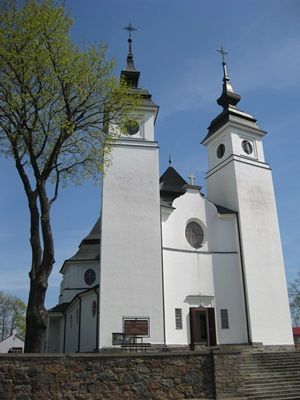Church of St. Agnes in Goniądz
Church of St. Agnes in Goniądz is one of the oldest parishes by the Biebrza. It is assumed that Prince Vytautas was its founder, but there is evidence that the church in Goniądz already existed in the 14th century when this land was a part of Masovia. In this important urban centre, located in the middle of the Radziwiłł family goods (called the Goniądz-Rajgród country due to their wide range), the parish church was not the only temple. In 1511 the Voivode of Vilnius, Mikołaj Radziwiłł, built a chapel by his castle, and around 1520 he founded a hospital church of the Holy Spirit by the hospital-shelter. This institution operated until 1794, when another wooden church under the same name, used as a storehouse during the Kościuszko Uprising, was devastated. Goniądz also owes the establishment of a vicarage next to the chapel of the parish church to Radziwiłł. The vicars were qualified to conduct additional masses. The foundation was a thanksgiving vote for defeating the Muscovite army at Orsha and the Krapivna River.
The last wooden church in Goniądz was a temple risen in the years 1775-1779 by the local rector and at the same time a coadjutor of Przemyśl and long-term secretary of Jan Klemens Branicki – Fr. Antoni Wacław Betański. Due to his contact with the manor in Białystok, the widow of Branicki – wife of the castellan of Cracow Izabela Branicka of the house Poniatowski – participated in the foundation of the church, and the court architect of the Branicki family, Jan Sękowski, became its designer. The new wooden temple was a spacious building with an elongated, three-sided enclosed chancel and two side chapels; a tower topped with a Baroque dome in a shape of a bell was annexed to the facade. In the side altar there was a miraculous painting of St. Anthony of Padua. This church operated in the parish for almost one and a half century. In 1915, as a result of bombing the church, the chancel and vestry with liturgical vestments and vessels, were demolished. The church was rebuilt after the war, but already in 1921 it was burnt in a fire, which consumed even its parish archive.

The last wooden church in Goniądz was a temple risen in the years 1775-1779 by the local rector and at the same time a coadjutor of Przemyśl and long-term secretary of Jan Klemens Branicki – Fr. Antoni Wacław Betański. Due to his contact with the manor in Białystok, the widow of Branicki – wife of the castellan of Cracow Izabela Branicka of the house Poniatowski – participated in the foundation of the church, and the court architect of the Branicki family, Jan Sękowski, became its designer. The new wooden temple was a spacious building with an elongated, three-sided enclosed chancel and two side chapels; a tower topped with a Baroque dome in a shape of a bell was annexed to the facade. In the side altar there was a miraculous painting of St. Anthony of Padua. This church operated in the parish for almost one and a half century. In 1915, as a result of bombing the church, the chancel and vestry with liturgical vestments and vessels, were demolished. The church was rebuilt after the war, but already in 1921 it was burnt in a fire, which consumed even its parish archive.












